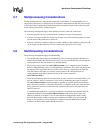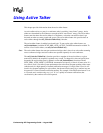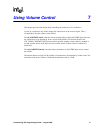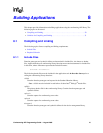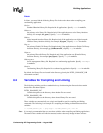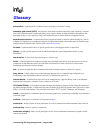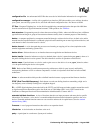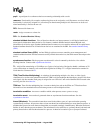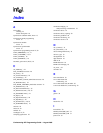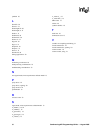
Conferencing API Programming Guide — August 2006 35
pupil: A participant in a conference that has a mentoring relationship with a coach.
resource: Functionality (for example, conferencing) that can be assigned to a call. Resources are shared when
functionality is selectively assigned to a call and may be shared among multiple calls. Resources are dedicated
when functionality is fixed to the one call.
RFU: Reserved for future use.
route: Assign a resource to a time slot.
SRL: See Standard Runtime Library.
standard attribute functions: Class of functions that take one input parameter (a valid device handle) and
return generic information about the device. For instance, standard attribute functions return IRQ and error
information for all device types. Standard attribute function names are case-sensitive and must be in capital letters.
Standard attribute functions for all Intel telecom devices are contained in the SRL. See standard runtime library
(SRL).
standard runtime library (SRL): An Intel Dialogic software resource containing event management and
standard attribute functions and data structures used by all Intel telecom devices, but which return data unique to the
device.
synchronous function: Blocks program execution until a value is returned by the device. Also called a
blocking function. Contrast with asynchronous function.
T1: A digital line transmitting at 1.544 Mbps over 2 pairs of twisted wires. Designed to handle a minimum of 24
voice conversations or channels, each conversation digitized at 64 Kbps. T1 is a digital transmission standard in
North America. Contrast with E1.
TDM (Time Division Multiplexing): A technique for transmitting multiple voice, data, or video signals
simultaneously over the same transmission medium. TDM is a digital technique that interleaves groups of bits from
each signal, one after another. Each group is assigned its own “time slot” and can be identified and extracted at the
receiving end. See also time slot.
TDM bus: Time division multiplexing bus. A resource sharing bus such as the SCbus or CT Bus that allows
information to be transmitted and received among resources over multiple data lines.
termination condition: An event or condition which, when present, causes a process to stop.
termination event: An event that is generated when an asynchronous function terminates. See also
asynchronous function.
thread (Windows): The executable instructions stored in the address space of a process that the operating
system actually executes. All processes have at least one thread, but no thread belongs to more than one process. A
multithreaded process has more than one thread that are executed seemingly simultaneously. When the last thread
finishes its task, then the process terminates. The main thread is also referred to as a primary thread; both main and
primary thread refer to the first thread started in a process. A thread of execution is just a synonym for thread.



